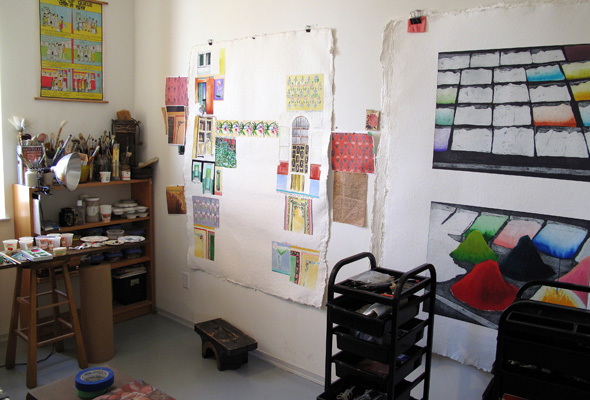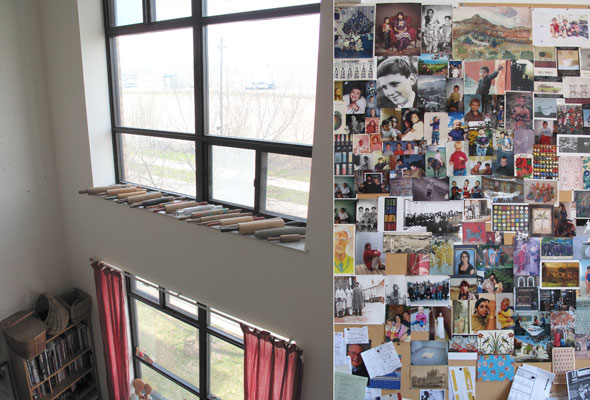
Habitats: New Toronto
As soon as I walk into Sarindar's home, I feel surrounded by bright colours and books. The best homes I've visited are "all of a piece" with our lives, our personalities; this is the feeling I get immediately in Sarindar's live-work space. Everything has purpose in this working art studio - even the chaotic melange of photos and keepsakes pinned to the walls. "Most of my work is made on a visceral and emotional level, not the cerebral level," explains Sarindar, "It's a bit like collecting bits of a life."
The studio is built the site of a former Goodyear Tire plant. "I used to say, 'I live in Etobicoke,' and people would look at me as if I'd said I lived on Mars. But if I said, 'I live in Mimico,' they said, 'Oh, that's lovely, by the Lake.' Really, I live in New Toronto."

Goodyear Tires closed this site in the 1980s, and the bright shiny concept of New Toronto is gone now too, swallowed up by Toronto-the-mega-city. But the Lakeshore Village Artist Coop managed to emerge from the brownfield zone. Its four buildings dedicated to artist live-work spaces, with rents tied to income, are located just past the Islington stop on the Queen West street car.
What: live-work artist space
Who: Sarindar, visual artist
How much: rent geared to income, variable (see below)
Layout: double-height main room with separate kitchen; upstairs, studio space & bathroom
Wedged beside Mimico, New Toronto's history is closely linked to the World Wars: soaring demand for rubber products during World War I led to the development of a Goodyear Tire plant in New Toronto in 1917. By World War II, there were 2,800 employees; the Goodyear blimp moored occasionally on the grounds. Now, the space is taken up with townhouses, condos, and a playing field.

"I knew a couple of people who were on the founding board," says Sarindar. She searched fruitlessly for live-in studio space downtown and became frustrated by how unfinished studio spaces were. "It meant putting in the plumbing, do the wiring..." Finally, her friends convinced her to visit their Lakeshore Village live-work studios. She was impressed.
Sarindar's rent fluctuates according to her earning power; currently she pays an average of $700 a month. Rents in the building vary from $150 to $1100, depending on tenants' income. "You have to be an artist to live here--and that includes not only visual artists, but theatre practitioners, photographers, writers. I think it's a nice community. It's not downtown, so it attracts a different kind of artist."
At first, an open-plan studio with a balcony was available, but it was eventually taken over by a 4-person family. So in 2006, Sarindar moved to her current double-height living space, with a catwalk staircase leading up to the work area. The big windows face north. The windowsills are decorated with carefully-arranged still lifes (my favourite is her collection of rolling pins, at the second-storey window). Bookcases overflow with books, papers, and gallery catalogues, and the walls are filled with paintings and prints.

There is one flaw in living away from downtown: "The neighbourhood makes you less inclined to go to things and sometimes I feel guilty about that." But in the next breath, Sarindar raves about the Queen streetcar. "The Queen Streetcar is one of the ten best trolley rides in the world - going from this New Toronto 1950s working class area through downtown all the way to the Beaches, which is the exact opposite of where we are. And I have a car. If you drive, it's a great location."
I go up the stairs to look at the studio. There's work-in-progress everywhere, pinned to the walls, stacked on shelves, with pieces of previous installations making do as furniture. Sarindar tells me about her ongoing Southall Project (she's working towards an installation at the Edward Day Gallery this October): "I've been making a lot of work about the dissonance of being an immigrant child and having one parent who was illiterate..." Sarindar grew up in the Southall region of London. Colour and memory are crucial aspects to her work, which pops with super-saturated hues.
We go back downstairs and drink tea at the dining room table, discussing different live-work buildings in the Toronto area. It's a constant struggle to find the right balance, we agree, to combine work and daily living in the same, fairly small, floorspace. "The people who build live-work spaces aren't necessarily artists. So artists can get caught up with bureaucracy. The live-work spaces don't always consider what artists need: space and light."

6 home questions:
What do you love most about your home? Sarindar appreciates the community of the building, but she's also practical about why she likes living here. "If you come here, rent-geared, it's a safety thing."
What drives you crazy? "There's no outside space. In my old place, I could sit [on the balcony] and watch the sun set."
What's your favourite place in your home? "It's quite beautiful to lie and look up at all the space. It's an interesting room, with the high ceiling."
What do you like best about the neighbourhood? "It's a really friendly area, down to the shopkeepers. The neighbourhood still has a Polish feel. And it has lots of cherry trees, unlike the central Toronto streets where there are older kinds of trees."
What's most surprising about this home? The odd sound of the wind. "In this building, I don't think the windows were fitted properly... I used to think I heard owls hooting!"
If your home were a kind of fruit, what would it be? "I have some favourite fruits." Sarindar finds a catalogue from one of her shows & shows me a painting. "This is Triple Self-portrait with Persimmons and Pomegranates. But I think this place is a starfruit. You know, the feeling that you have different pods and they're all connected. Of course I wish this was a pomegranate - with lots of cells; lots of rooms."
Latest Videos
Latest Videos
Join the conversation Load comments







